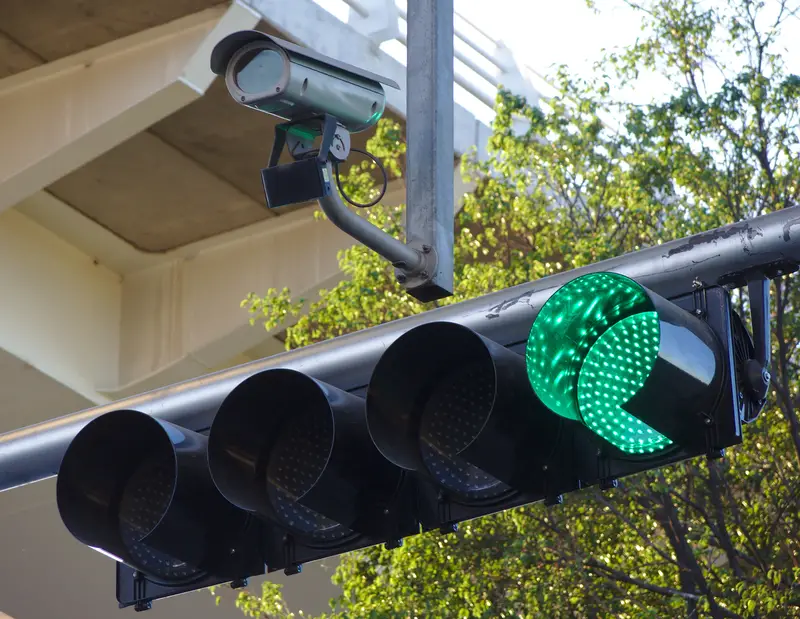Ever noticed those small boxes with lenses sitting on top of traffic lights during your morning drive? You’re not alone. Many of us spot these cameras and wonder what they’re actually doing up there. Are they watching us? Giving out tickets? Or something else entirely? It turns out these aren’t just simple cameras – they’re actually sophisticated tools that serve multiple purposes in our increasingly connected roadways. And no, they’re not all there to catch you when you’re running late and push through that yellow light.
These cameras help traffic flow better during rush hour
When you’re stuck in bumper-to-bumper traffic, those cameras are actually working to get you home faster. Traffic managers use these devices to monitor how many cars are at an intersection and how quickly they’re moving through it. This real-time information helps them adjust signal timing to match current conditions instead of relying on preset patterns. When traffic suddenly gets heavy in one direction, they can give that road more green light time to keep things moving along.
Think about how frustrating it is when you’re sitting at a red light with no cross traffic in sight. These cameras help prevent that situation by feeding information to traffic control centers that can make smart adjustments on the fly. They’re essentially the eyes of the traffic system, allowing operators to see problem spots without physically being there. In many modern cities, this information is automatically processed to create dynamic traffic flow patterns that change throughout the day based on actual conditions rather than just time of day.
Red light cameras catch dangerous drivers in the act
Some of these cameras are specifically designed to catch red light runners – and for good reason. Running red lights is one of the most dangerous driving behaviors, often leading to serious T-bone accidents. These special cameras are triggered when a vehicle enters an intersection after the light has turned red. They snap photos of the car’s license plate and sometimes the driver too. Studies have shown these cameras can make a real difference in safety – according to research, cities with red light cameras have seen a 21% drop in fatal crashes caused by red light running.
When the camera catches someone running a red light, it doesn’t just take one picture. The system typically captures multiple images showing the car behind the stop line when the light was red and then entering the intersection. It also records the date, time, location, and how long the light had been red. This creates a solid case that’s hard to argue with in court. While some people don’t like these cameras, the data shows they help make roads safer by encouraging drivers to stop when they should instead of trying to beat the light.
Not every camera is there to give you a ticket
Despite what many people think, not all traffic cameras are there to hand out tickets. In fact, many are simply traffic monitoring cameras that help officials understand patterns and manage flow. These cameras don’t record license plates or identify drivers – they just monitor how many vehicles are using the road and how quickly traffic is moving. This information helps traffic planners make better decisions about road improvements, signal timing, and where to focus resources to reduce congestion.
Some cameras are actually sensors that detect when vehicles are waiting at a light. Ever notice how sometimes the light changes right after you pull up? That’s because a sensor camera detected your car and signaled the light to change. Others are part of emergency vehicle systems that help ambulances and fire trucks get through intersections safely by changing lights as they approach. Understanding the difference between enforcement cameras and monitoring cameras can help ease concerns about privacy and surveillance. Most traffic departments are more interested in keeping traffic moving than watching individual drivers.
Speed cameras work differently than red light cameras
While they might look similar, speed cameras and red light cameras serve different purposes. Speed cameras are designed to catch drivers exceeding the posted limit, usually in areas with safety concerns like school zones or stretches of road with high accident rates. These cameras use radar or ground sensors to measure a vehicle’s speed and take photos when someone is driving too fast. The ticket usually arrives in the mail a few weeks later, showing the car, its speed, and the speed limit for that zone.
Speed cameras have been particularly effective in school zones, where protecting children is a top priority. According to research, these cameras have helped lower speeding and related deaths in these critical areas. However, they remain more controversial than red light cameras, with critics arguing they’re more about making money than improving safety. Some states have banned speed cameras entirely, while others have strict rules about where and how they can be used. If you see a camera near a traffic light in an area known for speeding problems, it might be there to monitor speed rather than red light violations.
Modern traffic cameras use advanced technology
Today’s traffic cameras are far more sophisticated than the simple video cameras of the past. Many now use artificial intelligence and machine learning to analyze traffic patterns automatically. These smart systems can count vehicles, determine their speed, identify congestion forming before it becomes a major problem, and even detect accidents or stalled vehicles. Rather than requiring a person to watch footage, the AI can alert traffic managers only when there’s an issue that needs human attention.
The newest cameras feature high-definition imaging that works in all weather and lighting conditions. Some can communicate with other nearby cameras to track traffic flow across multiple intersections. As cities develop “smart” infrastructure, these cameras are becoming part of larger networks that share data with navigation apps and even connected vehicles. This integration means that in the future, your car might receive a warning about congestion ahead or adjust its route based on information from these traffic cameras. The goal isn’t just to catch rule-breakers but to create a more efficient, safer road system for everyone.
Traffic cameras help with accident investigations
When crashes happen at intersections, figuring out exactly what went wrong can be tricky. Traffic cameras provide valuable evidence that helps police determine who was at fault. The footage can show which driver had the right of way, if someone was speeding, or if other factors contributed to the accident. This visual record often settles disputes that would otherwise be one driver’s word against another’s. For serious accidents, this evidence can be crucial for insurance claims and any resulting legal cases.
Beyond just determining fault, these recordings help traffic safety experts identify patterns in accidents at specific intersections. If they notice multiple crashes happening in similar ways, they can recommend changes to the intersection design, signal timing, or signage to prevent future incidents. The cameras essentially serve as 24/7 witnesses that don’t forget details or have biased perspectives. For drivers involved in crashes where fault is disputed, knowing a camera recorded what happened can actually provide peace of mind that the truth will come out, making the stressful aftermath of an accident a little easier to handle.
These cameras are part of smart city initiatives
Traffic cameras are increasingly becoming part of bigger “smart city” programs that aim to make urban areas more efficient and livable. These initiatives connect different systems like traffic lights, public transportation, and emergency services to share information and work better together. The cameras serve as important data collection points that feed into these larger networks. For example, they might detect heavy traffic and automatically alert bus systems to expect delays or suggest alternate routes through digital street signs.
As cities grow and roads become more crowded, these integrated systems help managers make better use of limited space. Some advanced systems can even adjust traffic patterns based on air quality readings, routing more cars away from areas with high pollution levels on bad air days. Others work with emergency systems to help ambulances and fire trucks reach their destinations faster by creating “green light corridors” along their routes. While privacy concerns remain important, the overall goal is using technology to make cities work better for the people who live in them. The traffic camera on your corner might be connected to systems that make your whole city run more smoothly.
Privacy concerns and how they’re addressed
Many people worry about having cameras watching them as they drive around town. It can feel like your privacy is being invaded, especially if you’re not sure what happens to the footage or who can access it. These are reasonable concerns that traffic departments take seriously. Most traffic monitoring cameras don’t record high enough resolution video to identify individuals or read license plates unless they’re specifically designed for enforcement purposes. And many systems have strict rules about how long footage can be kept and who’s allowed to view it.
Cities and states typically have laws requiring signs to be posted when enforcement cameras are in use, so drivers know they’re being monitored. For traffic flow cameras, the focus is on patterns rather than individuals – they’re watching the overall movement of vehicles, not specific cars or drivers. Data is usually anonymized when used for planning purposes. Some places have gone further by creating civilian oversight boards that review how camera systems are used and ensure they’re not being misused. These measures help balance the benefits of better traffic management with the public’s right to privacy. If you’re concerned about cameras in your area, most traffic departments are happy to explain their specific policies.
Traffic cameras may look intimidating perched above intersections, but they’re actually working to make your commute safer and more efficient. From reducing dangerous red-light running to helping clear accident scenes quickly, these electronic eyes serve important purposes beyond just handing out tickets. As technology improves, they’ll likely become even more integrated with other systems to create smarter, more responsive roadways. The next time you spot one of those camera boxes while waiting at a light, you can appreciate that it’s part of a complex system designed to keep traffic flowing and drivers safe.

